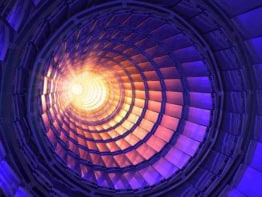The Large Hadron Collider (LHC) has lost up to a tonne of liquid helium after some of its superconducting magnets inadvertently heated up this morning, physicsworld.com has learnt.
A log entry written by the current LHC co-ordinator at 11:27 am CET (10:27 am BST) states that there has been a “massive quench” in sector 3–4. Quenches occur when superfluid helium in the magnets rises above its operating temperature of 1.9 K, and can be caused, for example, when a proton beam veers off course.
According to the entry, firefighters were dispatched to that area of the tunnel. It also says that the vacuum in that part of the beam pipe was lost.
A source at CERN, the European lab hosting the accelerator, says that the quench caused one tonne of superfluid helium — about 1% of the LHC’s total — to escape.
An official spokesperson was not available for comment. However, a message on the machine’s website states: “During the commissioning of the final LHC sector (sector 3–4) for 5 TeV operation, an incident occurred at 12:05 [am] today resulting in a large helium leak into the tunnel. Further details are not yet known. Investigations will continue over the weekend and more information will be made available as soon as possible.”
An LHC status report on the same website shows that temperatures are now being brought down, implying that technicians have been able to replace the lost helium.
The problem will be a disappointment to the operations team, who had enjoyed a highly successful media day last week when they circulated beams of protons in both directions around the machine’s 27 km-long ring.



